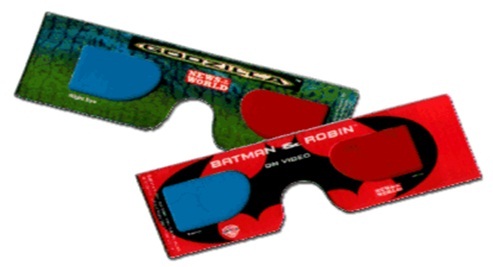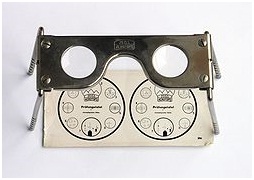





Published on Apr 02, 2024
We’ve seen that although there might be something complex going on behind the scenes, with the right equipment we can just sit back and let our eyes do the work. Of course, the technology wasn't always so simple; there have, in fact, been four generations leading up to today's 3-D glasses.
The first generation modified the games themselves to make them compatible with stereoscopic 3-D. The games' creators had to specifically support each type of LCD glasses -- hardly an ideal situation. There was no guarantee that the glasses you'd bought would work with your favorite game.
As you can imagine, that didn't appeal to many people; so a second solution was developed. This second solution was to override the game, actually taking over the computer's screen and altering what was displayed. As far as the game was concerned, it was just doing what it normally did, except, of course, that some of the computer's time was taken up processing the image to make it 3-D. The result was slower performance and low-resolution, blocky images. It did work with hundreds of games, though, and that was a definite improvement.
The third generation worked in a similar way, modifying the graphics driver but also maintaining the resolution of the images -- no more blocky graphics! Unfortunately, it wasn't compatible with many games, though it was a definite forerunner to the 3-D glasses we have nowadays. In the fourth-generation models, compatibility is high, the complicated work is done by the graphics card, and the lightweight LCD glasses flick so rapidly between the two images that all we see is crystal-clear, 3-D images.
3D PC glasses are designed for the serious gamer in mind. What are these specialized glasses, you ask? They are glasses that make the video games come to life in a way that increases the overall gaming experience for gamers of any age. You can do many things with these incredible glasses. You can enjoy games like never before.
These glasses are specifically designed to help convince your brain that you're literally right in the middle as part of the gaming experience. You don't have to use any fancy equipment. All you have to do is slip these glasses onto your head and all types of PC video games from RPGs to first person shooters are going to come to life in a way that they simply can't in two dimensions.
These glasses are used to turn a normal computer monitor into a real 3D object. What appears on the monitor from your game will look like its really right there, as well. Feel free to play any game that you want. It doesn't matter if it's "World or Warcraft" or "Modern Warfare," or any other game. You'll have a lot of fun with these 3D PC glasses. You'll find your online games to be a lot more interactive. Imagine the games you can play while wearing these glasses. You can play shooting games, airplane games, or any game you want. There's no limit to what games you can play.
These 3D PC glasses are perfect for children! They can bring all their learning games to life. Make their educational games much more interactive and fun. With these glasses, their imagination can run wild. There's no limit to what they can do.
You can find these 3D glasses online or at any game store. All you have to is search for them online. You can even read more information on these unique 3D glasses. You definitely won't find these 3D PC glasses anywhere else! Make the most out of your gaming experience with your own 3D PC glasses. You'll be glad that you made this decision

Stereoscopy (also called stereoscopic or 3-D imaging) refers to a technique for creating or enhancing the illusion of depth in an image by presenting two offset images separately to the left and right eye of the viewer. Both of these 2-D offset images are then combined in the brain to give the perception of 3-D depth. Three strategies have been used to accomplish this: have the viewer wear eyeglasses to combine separate images from two offset sources, have the viewer wear eyeglasses to filter offset images from a single source separated to each eye, or have the lightsource split the images directionally into the viewer's eyes
Human vision uses several cues to determine relative depths in a perceived scene.Some of these cues are:
• Stereopsis
• Accommodation of the eyeball(eyeball focus)
• Occlusion of one object by another
• Subtended visual angle of an object of known size
• Linear perspective (convergence of parallel edges)
• Vertical position (objects higher in the scene generally tend to be perceived as further away)
• Haze, desaturation, and a shift to bluishness
• Change in size of textured pattern detail

All the above cues, with the exception of the first two, are present in traditional two-dimensional images such as paintings, photographs, and television. Stereoscopy is the enhancement of the illusion of depth in a photograph, movie or other two-dimensional image by presenting a slightly different image to each eye and thereby adding the first of these cues (stereopsis) as well. It is important to note that the second cue is still not satisfied and therefore the illusion of depth is incomplete.
Many 3D displays use this method to convey images. It was first invented by Sir Charles Wheatstone in 1838. Stereoscopy is used in photogrammetry and also for entertainment through the production of stereograms. Stereoscopy is useful in viewing images rendered from large multi-dimensional data sets such as are produced by experimental data. Modern industrial three dimensional photography may use 3D scanners to detect and record 3 dimensional information. The three-dimensional depth information can be reconstructed from two images using a computer by corresponding the pixels in the left and right images (e.g.,). Solving the Correspondence problem in the field of Computer Vision aims to create meaningful depth information from two images
Two separate images are printed side-by-side. When viewed without a stereoscopic viewer the user is required to force his eyes either to cross, or to diverge, so that the two images appear to be three. Then as each eye sees a different image, the effect of depth is achieved in the central image of the three.
The stereoscope offers several advantages:
• Using positive curvature (magnifying) lenses, the focus point of the image is changed from its short distance (about 30 to 40 cm) to a virtual distance at infinity. This allows the focus of the eyes to be consistent with the parallel lines of sight, greatly reducing eye strain.
• The card image is magnified, offering a wider field of view and the ability to examine the detail of the photograph.
• The viewer provides a partition between the images, avoiding a potential distraction to the user.
Stereograms cards are frequently used by orthoptists and vision therapists in the treatment of many binocular vision and accommodative disorders
Complementary color anaglyphs employ one of a pair of complementary color filters for each eye. The most common color filters used are red and cyan. Employing tristimulus theory, the eye is sensitive to three primary colors, red, green, and blue. The red filter admits only red, while the cyan filter blocks red, passing blue and green (the combination of blue and green is perceived as cyan). If a paper viewer containing red and cyan filters is folded so that light passes through both, the image will appear black. Another recently introduced form employs blue and yellow filters. (Yellow is the color perceived when both red and green light passes through the filter.)
Anaglyph images have seen a recent resurgence because of the presentation of images on the Internet. Where traditionally, this has been a largely black & white format, recent digital camera and processing advances have brought very acceptable color images to the internet and DVD field. With the online availability of low cost paper glasses with improved red-cyan filters, and plastic framed glasses of increasing quality, the field of 3D imaging is growing quickly. Scientific images where depth perception is useful include, for instance, the presentation of complex multi-dimensional data sets and stereographic images of the surface of Mars.
With the recent release of 3D DVDs, they are more commonly being used for entertainment. Anaglyph images are much easier to view than either parallel sighting or crossed eye stereograms, although these types do offer more bright and accurate color rendering, most particularly in the red component, which is commonly muted or desaturated with even the best color anaglyphs. A compensating technique, commonly known as Anachrome, uses a slightly more transparent cyan filter in the patented glasses associated with the technique. Processing reconfigures the typical anaglyph image to have less parallax to obtain a more useful image when viewed without filters
I think we can safely say that the sci-fi hologram is a long way off, and may never happen. On the other hand, volumetric displays may happen in our life times. There are still technical obstacles to overcome, not to mention being able to manufacture them at a price that people will pay. In the meantime, other illusionary 3D displays, such as lenticular video may become popular, offering a 3D experience without cumbersome glasses. This is the end of this article, I hope that you enjoyed reading it
1.Flight Simulation, J. M. Rolfe and K. J. Staples, Cambridge University Press, 1986, page 134
2.Welling, William. Photography in America, page 23
3. Fay Huang, Reinhard Klette, and Karsten Scheibe: Panoramic Imaging (Sensor-Line Cameras and Laser Range-Finders). Wiley & Sons, Chichester, 2008
4.Dornaika, F.; Hammoudi, K (2009). "Extracting 3D Polyhedral Building Models from Aerial Images using a Featureless and Direct Approach" (PDF). Proc. IAPR/MVA. Retrieved 2010-09-26
| Are you interested in this topic.Then mail to us immediately to get the full report.
email :- contactv2@gmail.com |